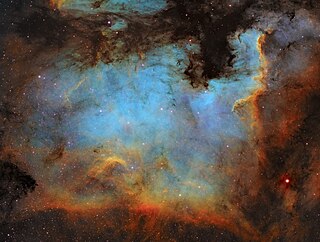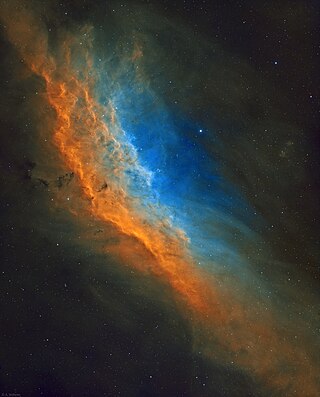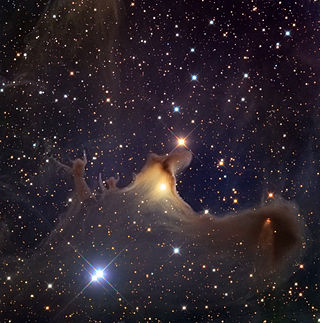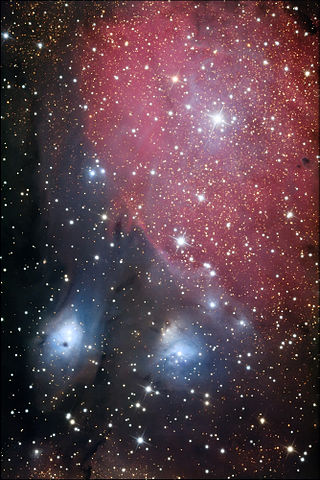
The Helix Nebula is a planetary nebula (PN) located in the constellation Aquarius. Discovered by Karl Ludwig Harding, most likely before 1824, this object is one of the closest of all the bright planetary nebulae to Earth. The distance, measured by the Gaia mission, is 655±13 light-years. It is similar in appearance to the Cat's Eye Nebula and the Ring Nebula, whose size, age, and physical characteristics are similar to the Dumbbell Nebula, varying only in its relative proximity and the appearance from the equatorial viewing angle. The Helix Nebula has sometimes been referred to as the "Eye of God" in pop culture, as well as the "Eye of Sauron".

Cassiopeia is a constellation and asterism in the northern sky named after the vain queen Cassiopeia, mother of Andromeda, in Greek mythology, who boasted about her unrivaled beauty. Cassiopeia was one of the 48 constellations listed by the 2nd-century Greek astronomer Ptolemy, and it remains one of the 88 modern constellations today. It is easily recognizable due to its distinctive 'W' shape, formed by five bright stars.

The North America Nebula is an emission nebula in the constellation Cygnus, close to Deneb. It is named because its shape resembles North America.

Alpha Cassiopeiae or α Cassiopeiae, also named Schedar, is a second-magnitude star in the northern constellation of Cassiopeia. Though listed as the "alpha star" by Johann Bayer, α Cas's visual brightness closely matches the 'beta' (β) star in the constellation and it may appear marginally brighter or dimmer, depending on which passband is used. However, recent calculations from NASA's WISE telescope confirm that α Cas is the brightest in Cassiopeia, with an apparent magnitude of 2.240. Its absolute magnitude is 18 times greater than β Cas, and it is located over four times farther away from the Sun.

Beta Cassiopeiae, officially named Caph, is a Delta Scuti variable star in the constellation of Cassiopeia. It is a giant star belonging to the spectral class F2. The white star of second magnitude has an absolute magnitude of +1.3 mag.

The California Nebula is an emission nebula located in the constellation Perseus. Its name comes from its resemblance to the outline of the US State of California in long exposure photographs. It is almost 2.5° long on the sky and, because of its very low surface brightness, it is extremely difficult to observe visually. It can be observed with a Hα filter or Hβ filter in a rich-field telescope under dark skies. It lies at a distance of about 1,000 light years from Earth. Its fluorescence is due to excitation of the Hβ line in the nebula by the nearby prodigiously energetic O7 star, Xi Persei.
A Gamma Cassiopeiae variable is a type of variable star, named for its prototype γ Cassiopeiae.

Sh2-279 is an HII region and bright nebulae that includes a reflection nebula located in the constellation Orion. It is the northernmost part of the asterism known as Orion's Sword, lying 0.6° north of the Orion Nebula. The reflection nebula embedded in Sh2-279 is popularly known as the Running Man Nebula.

The Veil Nebula is a cloud of heated and ionized gas and dust in the constellation Cygnus.

The Medusa Nebula is a planetary nebula in the constellation of Gemini. It is also known as Abell 21 and Sharpless 2-274. It was originally discovered in 1955 by University of California, Los Angeles astronomer George O. Abell, who classified it as an old planetary nebula. Until the early 1970s, the nebula was thought to be a supernova remnant. With the computation of expansion velocities and the thermal character of the radio emission, Soviet astronomers in 1971 concluded that it was most likely a planetary nebula. As the nebula is so large, its surface brightness is very low, with surface magnitudes of between +15.99 and +25 reported.

NGC 3576 is a bright emission nebula in the Sagittarius arm of the galaxy a few thousand light-years away from the Eta Carinae nebula. It is also approximately 100 light years across and 9000 light-years away from Earth. It was discovered by John Frederick William Herschel on 16 March 1834. This nebula has received six different classification numbers. Currently, astronomers call the entire nebula NGC 3576. A popular nickname is "The Statue of Liberty Nebula" because of the distinctive shape in the middle of the nebula. The name was first suggested in 2009 by Dr. Steve Mazlin, a member of Star Shadows Remote Observatory (SSRO). Within the nebula, episodes of star formation are thought to contribute to the complex and suggestive shapes. Powerful winds from the nebula's embedded, young, massive stars shape the looping filaments.

Sh2-155 is a diffuse nebula in the constellation Cepheus, within a larger nebula complex containing emission, reflection, and dark nebulosity. It is widely known as the Cave Nebula, though that name was applied earlier to Ced 201, a different nebula in Cepheus. Sh2-155 is an ionized H II region with ongoing star formation activity, at an estimated distance of 725 parsecs from Earth.

The Iris Nebula is a bright reflection nebula in the constellation Cepheus. The designation NGC 7023 refers to the open cluster within the larger reflection nebula designated LBN 487.

HD 21389 is a supergiant variable star in reflection nebula VdB 15, in the constellation Camelopardalis. It has the variable star designation CE Camelopardalis, abbreviated CE Cam. This object is part of the Camelopardalis OB1 association. The near-identical member CS Camelopardalis lies half a degree to the north.

V4381 Sagittarii is a variable star in the constellation Sagittarius. A white supergiant of spectral type A2/A3Iab, it is an Alpha Cygni variable that varies between apparent photographic magnitudes 6.57 and 6.62. Its visual apparent magnitude is about 6.54.

HD 165516 is a blue supergiant star in the constellation Sagittarius. It is part of the Sagittarius OB1 association and appears against a rich Milky Way starfield near the Triffid Nebula and Lagoon Nebula.

The Ghost Nebula is a reflection nebula located in the constellation Cepheus.

NGC 6590 is a reflection nebula in the constellation of Sagittarius. This nebula is near the similar reflection nebula NGC 6589. Both nebulas are flanked by red emission nebula IC 1284.

RCW 34 - H II region and the emission nebula located in the constellation Vela. It is located approximately 22,000 light years from Earth. Named after Australian astronomer Colin Stanley Gum.
Sh2-7 is an emission nebula in the Scorpius constellation. The nebula is around the star Delta Scorpii. It lies next to a large reflection nebula, Sh2-1.

















